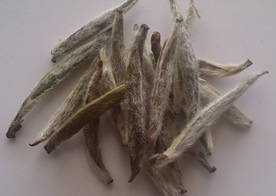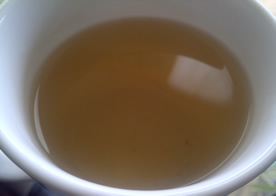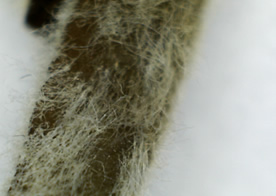 White tea is renowned for its subtle flavour, lack of processing, and most of all for its extreme health benefits and antioxidants. Originally from china, the plant from which white tea is derived (camellia sinensis) is used to make many other different varieties of tea including green and black. The flavours and variations associated with these teas are due to the individual processing methods and different stages of leaf used in manufacture.
White tea is renowned for its subtle flavour, lack of processing, and most of all for its extreme health benefits and antioxidants. Originally from china, the plant from which white tea is derived (camellia sinensis) is used to make many other different varieties of tea including green and black. The flavours and variations associated with these teas are due to the individual processing methods and different stages of leaf used in manufacture.
White tea, is a result of the finest new leaf buds carefully selected from specific strains of camellia sinensis, and is named after the fine hairs found on these leaves which give them a silvery or white appearance.
Health benefits of white tea
It is well documented that white tea leaves are rich in catechins. Catechins have been proven to reduce carcinogens in the body, reduce the severity of strokes and heart failure as well as diabetes, and even reduce the likelihood of some cancers.
White tea can also weaken certain cancers and help protect the skin from UV damage caused by the sun.
The drink can reduce blood pressure and cholesterol, improve the immune system and blood vessel function, slow the growth of viruses and bacteria in the body (including dental plaque, improving overall health of teeth), reduce the risk of arthritis, reduce the risk of heart disease, and help the skin to retain elastin and collagen.
When compared to other varieties, white tea contains around half of the caffeine content of green tea, and roughly one quarter the caffeine content of black.
Perhaps the most famous of all of white teas benefits is the fact that it, along with other varieties, is an extremely rich source of polyphenols (a type of antioxidant). These polyphenols are some of the strongest known, and white tea contains more than any other variety.
Antioxidants and free radicals
It is well understood that free radicals are bad for the body, but it is commonly unknown by most people as to why this is.
A free radical is essentially a rouge atom capable of destroying human cells, enzymes, molecules and dna when it comes into contact. The body is full of free radicals due to its exposure to sunlight, the digestion of food and many other causes. These free radicals are constantly doing minor damage to our bodies, making us slowly deteriorate and age. They are in fact considered to be the leading cause of aging.
Antioxidants are a natural defence mechanism used by both plants and animals to fight free radicals by neutralising them.
Plants create their own antioxidants in varying amounts which they use to fight the free radicals resulted from the absorption of sunlight, and these antioxidants are absorbed by our bodies when we consume plant matter, including white tea.
White tea contains powerful antioxidants in a much higher concentration than other varieties including green and black.
Preparation and harvest
White tea is harvested from the fine silvery white leaf buds or leaves of the camellia sinensis plant.
This process is in most cases carried out by hand in the beginning of spring to ensure that only the correct leaves are selected.
Unlike other teas, there is essentially no other processing beyond this point, meaning that harvested leaves are simply dried out via means of sun drying, air drying or by other methods, although withering of the leaves is a practice occasionally used before the drying process.
This lack of processing assists in the retention and preservation of the various nutrients and antioxidants contained in the leaves, as well as allowing the natural flavour to remain undisturbed.
Harvesting the leaves at different times of year or in different weather situations and temperatures can change the flavour and quality, leading many growers to harvest under very specific conditions.
White tea varieties
 White tea is divided into various categories or, grades.
White tea is divided into various categories or, grades.
The highest quality type of white tea is called ‘silver needle’. Silver needle (Yin Zhen Bai Hao) is compiled of only white buds, making it the purest of all white teas.
‘White peony’ is the second highest grade of white tea as it is made up of both leaf buds and small leaves, which also have fine white hairs on them.
Lesser varieties of white tea include Snowbud, and Long life eyebrow. These varieties are said to be of inferior quality to white peony and silver needle, usually noted for their stronger flavour and darker colour.
The quality of white tea is often judged by the amount or density of white hairs found on the buds and leaves, although this method is not always considered to be an accurate measurement.
Creating the perfect cup of white tea
White tea is soft, subtle and complex in flavour, and each cup you create should reflect this.
There are many different factors that affect the flavour and aroma of white tea, and this allows the drinker to experiment and create their own perfect cup.
It is always said that a cup of white tea should be made using one to two teaspoons of leaves and steeped in hot water (not boiling).
This can be used as a guideline, but can be changed to suit the drinker.
Although most white tea drinkers drink white tea without additives, it can be made with milk and sugar just as black tea is most often consumed.
The steeping time of white tea makes a profound difference to the overall flavour. The leaves should be steeped for a minimum of 2 to five minutes before drinking, however, steeping for fifteen minutes can create a stronger flavour, considered by some to be almost lemony.
The temperature of the water poured over the leaves is said to make subtle changes to the flavour and strength along with the amount of water and perhaps even the mug used to drink it.
High quality leaves can be re-used multiple times but should be discarded after they lose their flavour, or as each day passes.
To gain the full benefits of white tea, three or more cups should be consumed on a daily basis.
Buy some white!
White tea is often difficult to find locally for purchase and it is for this reason that many have given up the hunt. Luckily the internet is an easy place to find quality stockists boasting various blends and varieties. Below are a few Australian sellers with a quality cup on offer.
| Valleygreen | The tea centre | Leaf tea |
